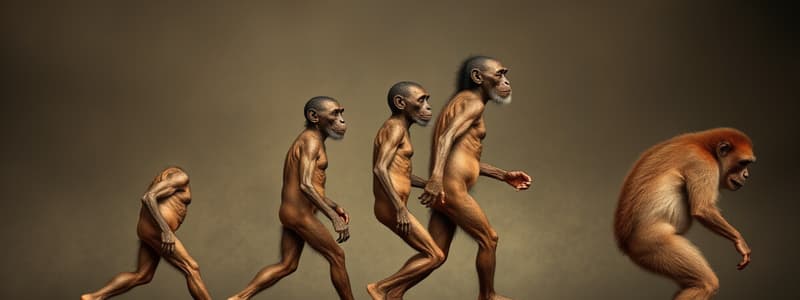Podcast
Questions and Answers
The first true human, known as the Handy Man, is referred to as ____.
The first true human, known as the Handy Man, is referred to as ____.
Homo Habilis
What species is known as 'The Upright Man'?
What species is known as 'The Upright Man'?
Homo Erectus
Which of the following species is considered a direct descendant of modern man?
Which of the following species is considered a direct descendant of modern man?
- Cro-Magnon Man (correct)
- Homo Erectus
- Homo Sapiens (correct)
- Neanderthal Man (correct)
Humans are the only fully bipedal primates.
Humans are the only fully bipedal primates.
What significant capacity is facilitated by the developed brain of humans?
What significant capacity is facilitated by the developed brain of humans?
What are the two types of grip developed in humans?
What are the two types of grip developed in humans?
Which of the following is a characteristic of human speech compared to chimpanzees?
Which of the following is a characteristic of human speech compared to chimpanzees?
Match the following species with their nicknames:
Match the following species with their nicknames:
Flashcards are hidden until you start studying
Study Notes
Hominids and Human Evolution
- Hominids evolved approximately 40 million years ago, leading to "manlike primates."
- Key early species included Ramapithecus, Lucy, and Homo Habilis.
Homo Habilis
- Known as "Handy Man," lived around 2.4 to 1.4 million years ago.
- First hominids to utilize stone tools for defense and hunting.
Homo Erectus
- Referred to as "The Upright Man," believed to have existed around 1.9 million to 110,000 years ago.
- Known for refined stone tools and an upright walking posture.
- Major fossil discoveries include Java Man (Pithecanthropus Erectus) and Peking Man (Sinanthropus Pekinensis).
Homo Sapiens
- Commonly known as "The Thinking Man," emerged around 300,000 years ago.
- Exhibited physical similarities to modern humans and cultural practices like burial of the dead and tool use.
- Notable subspecies include Neanderthal Man and Cro-Magnon Man, each with unique adaptations to their environments.
Biological Development of Humans
- Four primary capacities have facilitated human cultural development:
- Thinking Capacity: Larger brain size (about 1.4 kg) compared to other primates allows for advanced cognitive skills.
- Gripping Capacity: Humans possess straighter digits and a longer thumb, enhancing tool-holding capabilities and dexterity.
- Speaking Capacity: A more extended vocal tract and flexible tongue enable a broader range of sound production compared to non-human primates.
- Walking/Standing Capacity: Humans are fully bipedal, allowing for efficient movement and the ability to carry objects, facilitating activities such as hunting.
Summary
- The evolution of hominids illustrates the journey from primitive "manlike primates" to complex beings capable of culture, language, and intricate tool use, defined by anatomical and cognitive advancements.
Studying That Suits You
Use AI to generate personalized quizzes and flashcards to suit your learning preferences.



